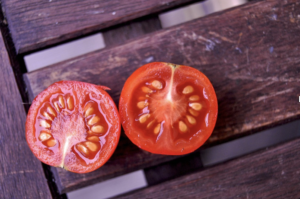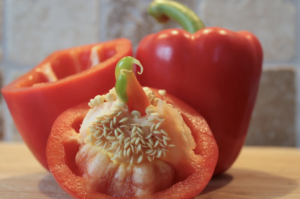~Luis Guerra~
We all love to grow our veggies, care for them, harvest them, and then prepare amazing meals. Every year we purchase new seeds for our favorite crops, but it can also be really rewarding to harvest and save seeds from our own vegetable plants to use for next year’s garden. When we buy seeds, we hope we end up with a delicious plant or fruit, but if you save seeds from a particularly tasty or prolific plant you grew yourself, you’ll know for sure what you’ll be getting next growing season.
Seed harvesting is so simple, and you can try it pretty much immediately with some of the summer varieties currently growing in your garden. You can harvest seeds from just about any plants, but there are some that are certainly more popular and easier to harvest and preserve than others.
Depending on the crop you would like to try to harvest seeds from, there are certain practices you will need preform to have success. I’ll outline the process for a few different plant varieties below:

- Tomatoes: Only save heirloom seeds from tomatoes, as hybrid tomato plants will not grow ‘true to seed.’ Harvest some fully-ripened fruit from the plant. Cut open the fruit and scoop out all the seeds inside the tomato, leaving the flesh behind. Add the seeds to a glass jar with some water, and let the seeds soak for a week or so. All the pulp surrounding the seed will separate. Carefully pour the seeds out into a strainer. Wash the seeds under water one last time, and set them to dry on a paper towel. Place seeds on top of a bookshelf away from direct light until thoroughly dried and then store in a paper bag for next year’s use.
- Carrots: In order to save carrot seeds, you will need to allow the carrot to live in your garden for two years. After it flowers, let the flower dry while still attached to the plant . Plan to harvest the seeds during a good dry spell to insure your seeds don’t go moldy. Harvest the seed pods and allow them sit out in a dry location away from direct sunlight, similarly to the tomato seeds. Store in a paper bag for next year.

- Peppers: Some of the easiest plants to save seeds from. Let peppers fully ripen on the plant (let red peppers get fully red, yellow peppers fully yellow, etc) before harvesting. For larger peppers (bell peppers, for example) simply cut open the pepper and scrape the seeds from the core. Rinse any seeds that may have pulp on them, and then spread seeds out on paper towels to dry out of the sun in a place with good air circulation. When thoroughly dry, store in a paper bag until planting time. For smaller, thin-walled peppers (like habaneros or cayennes) harvest the peppers, and allow the fruits to dry in a protected location until the flesh is brittle enough to break apart easily. Break open the dried peppers and collect the seeds for planting.
- Kale: Another biannual plant , similar to carrots, kale will flower the following year after planting. When you start noticing the leaves dying from bottom to top, harvest the seed pods and hang them indoors to dry in a dark, cool space. Break out the seeds from the pods, and there you have it, a large kale seed collection for next year.
Many other plants we like to cultivate work similarly to the varieties discussed here. We encourage you to write in the comments below which plants you have had success harvesting seeds from.

Michael Curtice says
I just harvested Georgia Southern collard greens seed from last season, radish and dill seed from this season. Waiting for this season’s herb seed (borage, basil, motherwort and wildflower) to mature. I’ll be harvesting 70 heirloom tomato, 45 pepper varieties and 6 corn this season, also. I own/operate a vegan organic urban/seed production farm in Omaha, Nebraska. I steward a large heirloom/O-P vegan organic seed collection. Feel free to contact me at gratefulseedsaver@gmail.com.
c williams says
do all saved seeds need to come from heirloom or just the tomatoes?
ashley says
You want to save seeds from non-hybridized varieties, as seeds from hybrid plants are often infertile, and also don’t generally produce exact replicas of the fruits you take them from. So look for open-pollenated or heirloom plant varieties that set fertile seeds that will grow true.